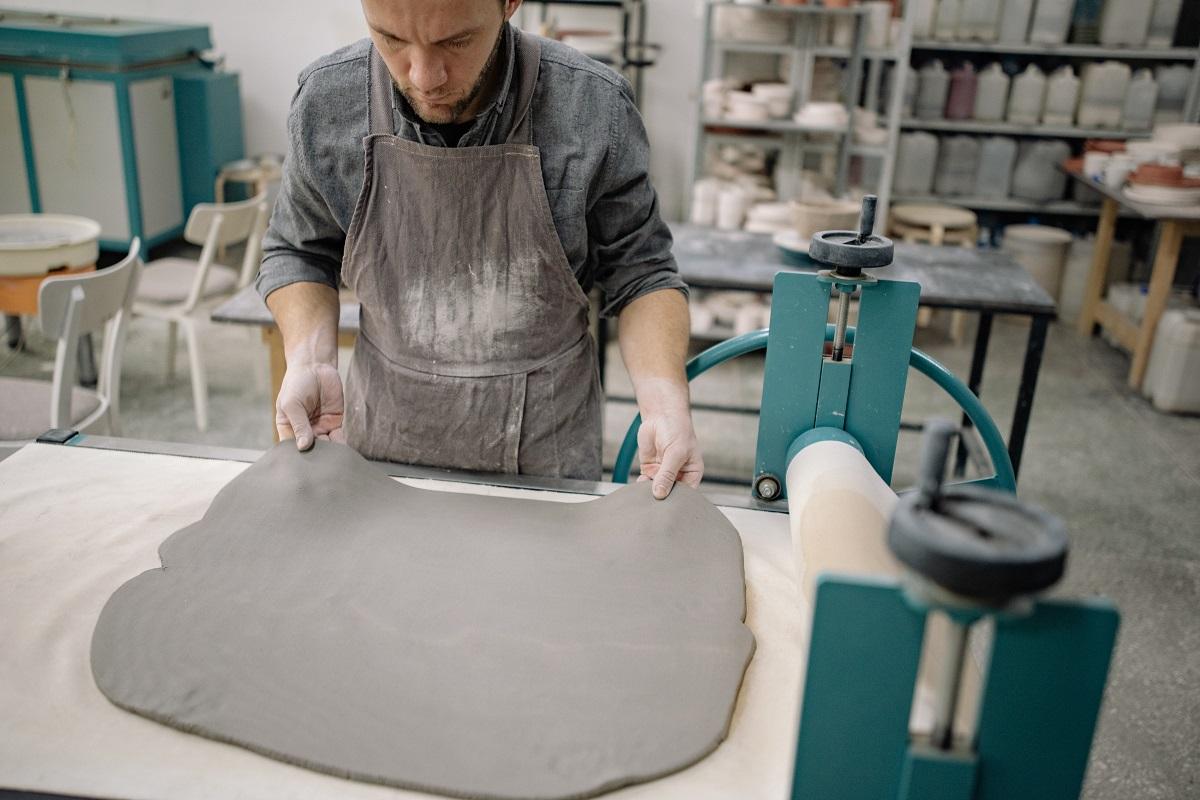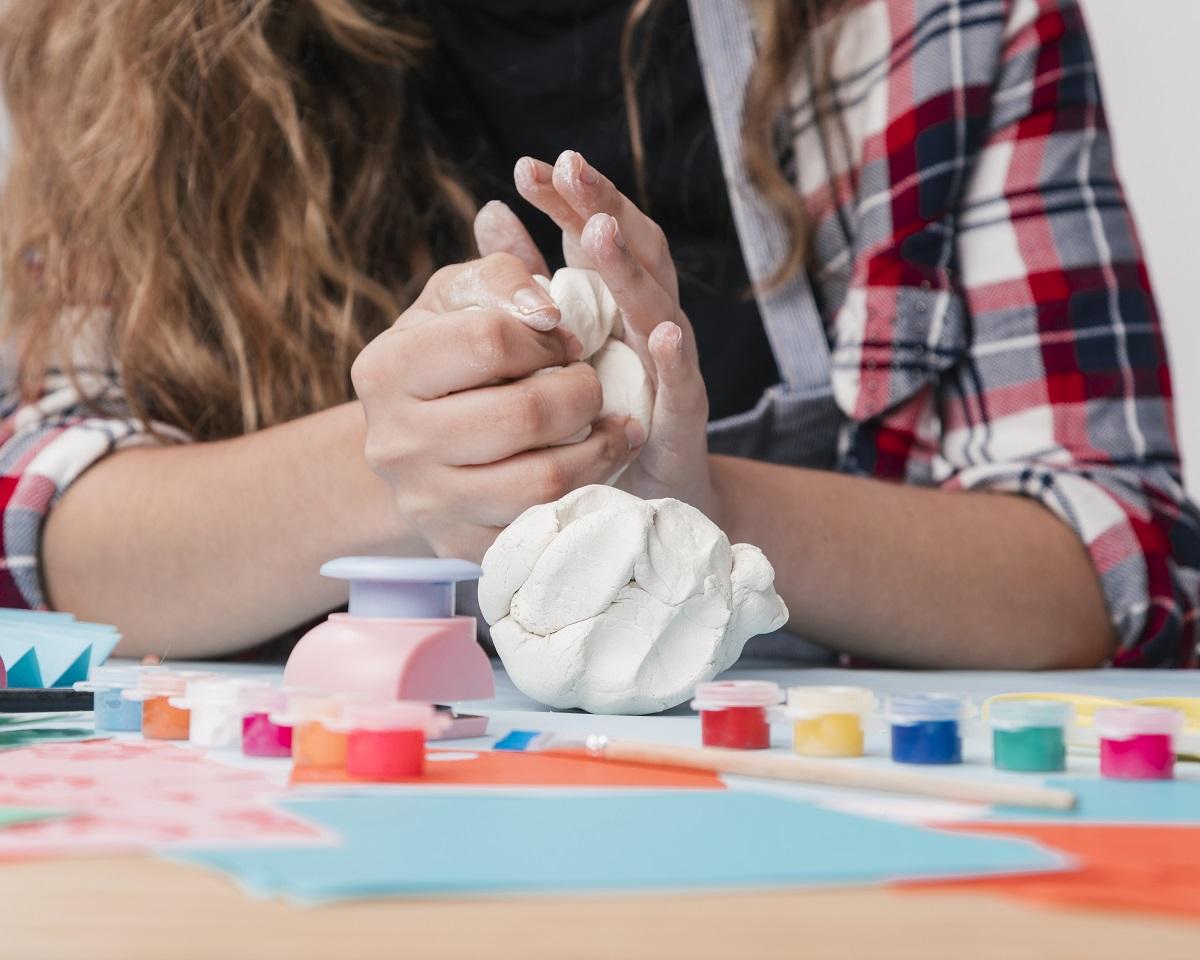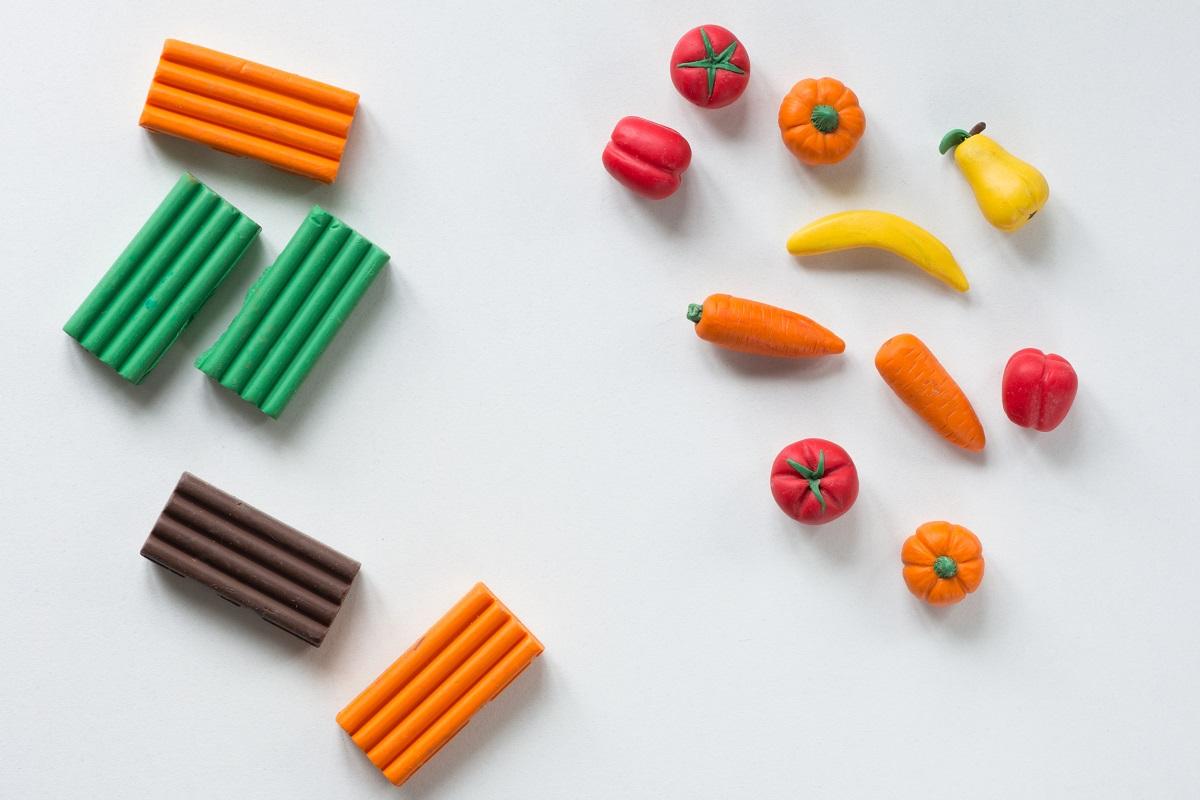When it comes to the best clay for sculpting, there are different options you can use to get the job done, but polymer and air dry clay are the most preferred ones.

While both may look similar, they have unique properties when it comes to the sculpting process. In general, polymer clay requires intense heat to dry up, while air dry clay only requires proper air ventilation.
Moreover, the former is suitable for complex clay art projects since it is extremely durable. On the other hand, air dry modeling clay will come in handy for first-timers to explore their creativity.
Both these options have a wide range of applications and advantages. So, keep reading if you want to learn more about the difference between polymer clay and air-dry clay.
Overview Of Air Dry Clay

Air dry clay needs the least introduction since it is widely used by kids and adults for various projects and creative sculpting. It doesn’t matter if you lack experience since the clay can easily be manipulated.
The air dry clay mixture is made from natural materials, such as glue and paper fibers. As such, the clay is ideal for kids since it doesn’t have any harmful chemicals that can cause severe reactions on their skin.
Moreover, it doesn’t require any firing since it can easily dry in a well-ventilated room on its own. However, the main reason why air dry clay has risen in popularity is because it is extremely affordable and doesn’t require a conventional oven for curing.
Nevertheless, air dry clay does have a few major drawbacks. Firstly, it takes around 24 to 72 hours for the crafting projects to dry completely. Secondly, it is not very suitable for delicate projects such as making jewelry as it is vulnerable to cracks.
How To Use Air Dry Clay
Here are a few steps you will need to follow to get the best results from air dry clay.
Step 1:
Firstly, you should clean the surface of your workstation to make sure there’s no dirt, debris or moisture. After this, remove the clay from the packaging and place it on the surface.
Step 2:
Start kneading the clay till it achieves a soft texture.
Step 3:
Once the clay is soft, start to mold the clay and give it the desired shape.
Step 4:
Let it dry in a well-ventilated room for around 24 to 72 hours.
Overview Of Polymer Clays
Polymer Clay is the most versatile clay on the market since you can use it for different purposes, such as making home decor items, pottery, jewelry etc. It can be used for making intricate and complex designs without any difficulty.
Generally, polymer clay is made from polymer polyvinyl chloride, and it is manufactured on a commercial level since the material is used for making high-end home decor accessories. Apart from this, it is available in a wide range of color options; hence, you can choose the right one to suit your project's needs.
When it comes to drying, the polymer clay craft usually takes around 10 to 30 minutes to completely dry. However, you will require a large kiln or a kitchen oven since the drying process requires intense heat.
As soon as the clay dries up, it becomes extremely durable and resistant to water.
Another advantage of using polymer clay is that you don’t need to worry about the clay drying quickly when exposed to air. This makes it extremely convenient for sculptors and crafters since they can take breaks without having to worry about wasting any clay.
How To Use Polymer Clay
The process of using polymer clay usually requires some strict techniques and skills. With that in mind, we have listed the following guidelines for you to follow while using polymer clay.
Step 1:
Clean the workstation to remove any dirt or debris from the surface before placing the clay on it.
Step 2:
For the next step, you should condition the clay by kneading it with your hands and pressing it on the work surface. You can use a pasta machine for softening the clay till it reaches the required smoothness.
Step 3:
Once you condition the clay properly, give it the required shape and structure by molding it with your hands.
Step 4:
Lastly, let it cure in a preheated oven or furnace at a temperature of 275-degree Fahrenheit for around 15 minutes. After it gets baked completely, remove it from the oven and let it dry for another 15 minutes.
What Are The Main Differences Between Polymer Clay And Air Dry Clay?

Despite being similar in nature, air dry clay and polymer clay have their own unique properties and serve different purposes. Hence, we have listed a few key factors that can help you to decide which clay will be the ideal choice for a sculpting project.
1. Application And Ease Of Use
Air dry clay is well known for being one of the easiest clays to work with. Even kids and beginners can enjoy working with it since it doesn’t require any specialized technique. Moreover, you can easily shape the clay to make different sculptures.
On the other hand, polymer clay requires strict conditions and techniques so that you can mold it easily. In fact, you can’t mold the clay until you have kneaded it to a smooth and soft consistency. Therefore, polymer clay is mostly used by experienced crafters.
2. Dependency On Heat
Can you bake modeling clay without heat? Your answer would probably be ‘no’ since most clays require heat to mature completely. However, this isn’t the case with air dry clay. Air dry clay is made from a special material that allows it to dry and harden as soon as it gets in contact with air. A well-ventilated room will get the job done perfectly.
In contrast, a polymer clay craft will require a kiln to harden since it requires intense heat to dry completely. If you don’t own a kiln, then you can use the kitchen oven instated for baking the clay craft.
3. Drying Time
Despite being an easy-to-use clay, the air dry clay has one major drawback- it requires a minimum of 24 hours to 3 days to dry completely. If the moisture content in the room is dry, then the clay craft will take a longer time to dry. In addition, you will need to use an acrylic sealer for adding an extra layer of durability to the clay surface.
Although polymer clay requires a kiln to harden, it takes less time to dry up. For instance, it usually takes around only 15 minutes for one-fourth of the thickness to dry. At the same time, you will be required to give it an additional 15 minutes to cool down before you can touch the clay sculpture.
4. Durability
When it comes to durability, air dry clay sculptures are usually fragile and prone to getting cracked especially if moisture is trapped within the clay. Additionally, if you plan to make clay jewelry, such as air-drying clay earrings, you will need to be very careful.
On the contrary, polymer clay sculptures are usually very durable and rigid after they are baked and dried completely. Moreover, the finished projects become water-resistant immediately after drying, making it a suitable option for designing a range of items.
5. Storage
Air dry clay requires a dedicated airtight container to avoid cracking since it can easily dry when it comes in contact with air. If air gets trapped within the container or the storage unit, then the clay will start to crack, and you wouldn’t be able to use it again.
However, you don’t need any strict storage requirements for polymer clay. After you are done with the project, you can store the leftover clay in the original packaging till you need to use it again. Just make sure that the room doesn’t get too hot since heat can dry up the clay over time.
6. Affordability
Apart from the application, you should always choose the clay that suits your budgetary needs. Air dry clay is usually extremely affordable; hence, you can buy the clay in bulk and use it for different projects.
In contrast, polymer clay is usually costly, making it less accessible to hobby crafters.
7. Versatility
Air dry clay is extremely versatile since people can use it irrespective of their experience. Also, it can easily dry up without any heat application. Air-dry modeling clay is usually available in three colors: terracotta, white and gray.
Polymer clay is well-known for being available in a wide range of color options, and some clays come with a unique texture option that gives the final sculpture a different finish altogether.
Air Drying Clay Vs Polymer Clay Frequently Asked Questions ?
What Causes Air Dry Clay To Crack?
One of the major problems with air-dry clay is that it can crack easily when it shrinks due to dry weather conditions. However, you can prevent the sculpture from cracking by placing it in a room that isn’t too dry or using a humidifier.
But keep in mind that too much water will also damage the clay. Hence, you should avoid using too much water on the clay since it can cause the surface to develop cracks once the water starts evaporating.
How To Determine If The Polymer Clay Has Baked Properly?
The quickest way to check if your polymer clay craft project has baked properly is by removing it from heat, letting it cool down and touching it gently. If you observe finger impressions on it, then the clay needs more time to bake.
When Should You Use Acrylic Paint On Air Dry Clay?
Generally, it is recommended to wait for at least three days so that the air dry clay project can dry up completely. If you don’t let your air dry crafts to dry completely, it can cause moisture to enter the clay craft.
Whenever excess moisture gets trapped within the clay craft, it forms cracks on the surface due to water evaporation. Therefore, you should let the project dry completely before using any acrylic paint.
Is It Possible To Dry Air Drying Clay Faster?
Technically, you can speed up the drying process of air dry clay by using a dehydrator. However, you will need to take the right precautions while using this device. For instance, you should choose the lowest setting and try not to use it for too long since it can cause discoloration of the clay craft.
Moreover, excessive use of dehydrators can cause your air-dry clay projects to develop cracks since the clay will shrink faster than it should.

Air Drying Clay Vs Polymer Clay Final Words
As mentioned earlier, there is a wide range of applications for both polymer and air-drying clay. However, it ultimately boils down to the user to decide which clay is suitable for his or her needs.
Before leaving, here are a few tips you can use to determine which clay will suit your current needs. For starters, beginners are recommended to use air-dry clay since it is easy to shape and use.
On the other hand, polymer clay may be more suitable for experienced sculptors and creators. Moreover, if you’re on a tight budget, then you should use air-dry clay since it is cheaper than polymer clay.
With that, we are signing off for today, but watch this space for more such reads. See you next time!
